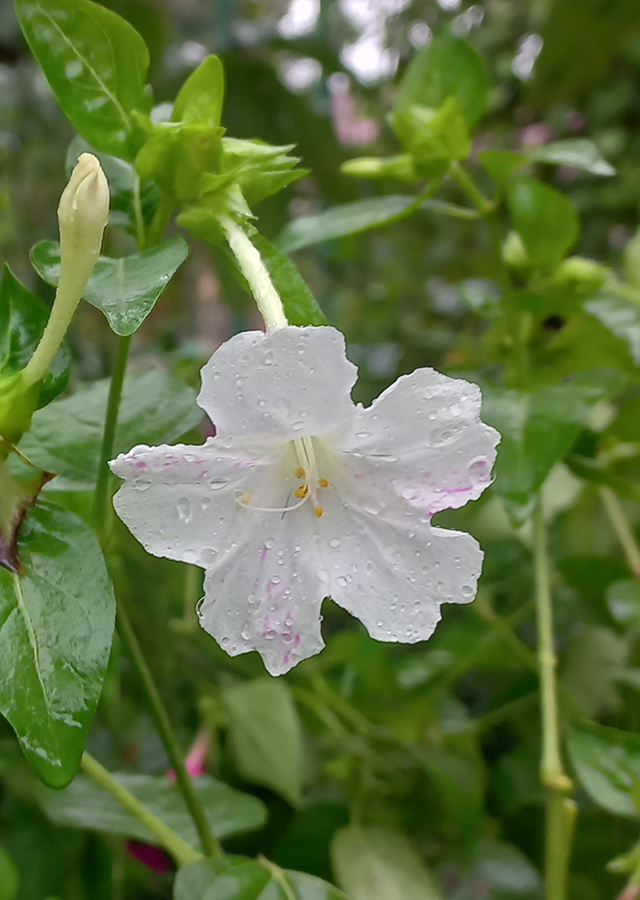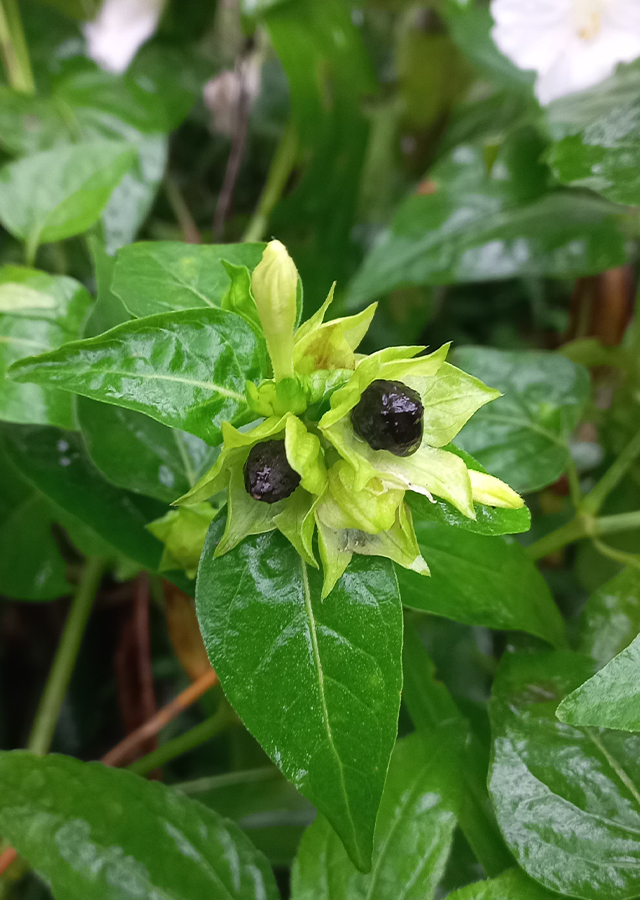Traditional Herbs from Mirabilis jalapa
boils
- Prepare enough four o'clock flower leaves, wash them thoroughly.
- Crush them until they become a paste.
- Put the leaf paste on the affected area.
laxative_medicine
- Take four o'clock flower leaves as needed, wash until clean.
- Boil until boiling.
- Let it warm/cold.
- Strain then drink.
What is Mirabilis jalapa Looks like??



Parts of Mirabilis jalapa that could be used
- Leaves", "Seeds", "Flowers", "Fruits", "Roots", "Tubers", "All Parts of the Plant
Mirabilis jalapa Distribution
The four o'clock flower or Mirabilis jalapa is a flowering plant from the Nyctaginaceae family which is thought to originate from Mexico to Central America. This species is also found in North America, Central America, the Caribbean, South America, Europe, Africa, Asia, and Oceania. This species has been introduced to various continents and cultivated as an ornamental plant since the 1500s. M. jalapa also has various other functions in society, including as a source of coloring for cosmetics, cakes and jellies, cosmetic powder, beads, medicinal plants, vegetables, spices. Where the leaves can be eaten and used as emergency food, the seeds are also used as a substitute for pepper. As a medicinal plant, M. jalapa has also been widely used in several countries as a traditional medicinal ingredient which is believed to be able to treat various disease complaints. This species is listed as invasive in Asia (China, Indonesia, Maldives, Philippines), Africa (Kenya, Seychelles, South Africa, Uganda), South America (Chile, Ecuador) and Oceania (Cook Islands, Federated States of Micronesia, Fiji, Hawaii- USA, Kiribati, Nauru, New Caledonia, New Zealand, Niue, Pitcairn, Tonga, US Minor Outlying Islands).Agroecology of Mirabilis jalapa
The original habitat of M. jalapa is believed to be on forest edges, bushes and grasslands. This species is also commonly found growing in waste land, disturbed locations, roadsides, abandoned fields, and railroad tracks. Found at altitudes ranging from near sea level to 3000 m above sea level. M. jalapa can grow in almost all types of soil, as long as it is fertile, well-drained, both in full sun (6 - 8 hours of sunlight) to partial shade, with a soil acidity (pH) of 6.1 to 7.8 . The growth of M. jalapa is also tolerant to salt and drought.
Morphology of Mirabilis jalapa
- Tap root, tuberous (tuberous), black or black-brown.
- Stem erect, many-branched, cylindrical, glabrous or slightly pubescent, bulging at the nodes.
- Leaves unifoliate, arranged oppositely (opposite), round in shape egg (ovate) or ovatetriangular leaf base truncated or heart-shaped, flat leaf edges, pointed leaf tips (acuminate), venation pinnate. Petioles about 1-4 cm.
- Flowers usually clustered at the top of the branches, arranged in 3-7 groups, trumpet-shaped, lemon-scented, 5-lobed, triangular-ovate lobes, pointed, glabrous (flower ornaments) various colors (purple, red, yellow, white, or variegated), tubular in shape, open in the afternoon and close the next morning. Stamens number 5, stalk sai (filament) slender, anther (anther) round (globose). White starchy endosperm.
Cultivation of Mirabilis jalapa
- Plant propagation can be done generatively through seeds and vegetatively through tubers and stem cuttings.
- Even though the flowers are morphologically adapted for crossing, this species is reported to be mostly a selfer. This species can self-pollinate by rolling stamens towards the stigma when the flower closes.
Mirabilis jalapa, more details :
Chemical Content of Mirabilis jalapaOxymethylanthroquinone, trigonelline, galactose, arabinose, steroids, tannins, saponins, inulin, flavonoids, glycosides, triterpenoids, chrysophanol, physcion, stigmasterol, mirabijalone A, boeravinone C, aurantiamide acetate, glycerin monoeicosate, β-sitosterol, 4-hydroxy-3- methoxybenzoic acid, astragaloside II, astragaloside II, astragaloside IV, astragaloside VI, flazin, 4'-hydroxy-2, 3-dihydroflavone 7-beta-D-glucopyranoside, gingerglycolipid A, 3, 4-dihydroxybenzaldehyd, p-hydroxybenzaldehyde, beta-sitosterol , daucosterol, phenolic compounds (hydroxycinnamic acids, isoflavonoids, coumarin).
Benefits of Mirabilis jalapa
Treats dropsy, scabies, boils, abscesses, eczema, skin infections and itching, diabetes, muscle swelling, urinary tract infections, diarrhea, dysentery, indigestion, rashes, hemorrhoids, conjunctivitis, reduces swelling due to fractures and swelling normal, reduces fever, relieves headaches, treats syphilis wounds, treats vaginal discharge, treats intestinal parasites. Acts as an aphrodisiac, diuretic, laxative and anti-inflammatory.
Simplisia of Mirabilis jalapa
- Prepare enough fresh roots of four o'clock flowers, wash thoroughly with running water then drain.
- Dry in the sun or in an oven at a temperature\u00a040\u00b0C until the water content\u00a010%.\u00a0
- Store in a clean container and airtight.
Another Facts for Mirabilis jalapa :
Synonym of Mirabilis jalapaMirabilis jalapa f. eujalapa Heimerl, Nyctago hortensis Dum.Cours., Nyctago jalapae (L.) DC.
Habitus of Mirabilis jalapa
Herb. Herbaceous, annual (perennial), but used as an annual plant in temperate climates, up to 1 m high
Habitat of Mirabilis jalapa
- Forest
- Roadside
- Bush Area
No comments:
Post a Comment